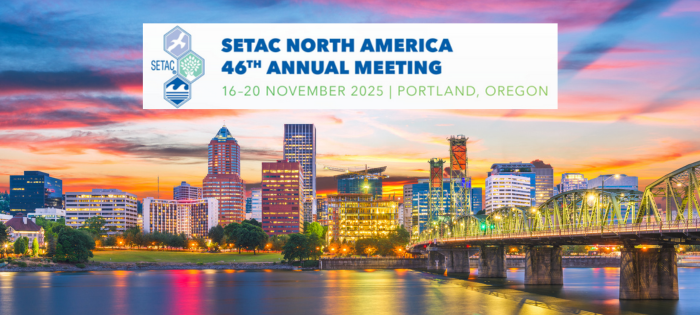
KTL to Present on Human Health Risk Assessments
KTL will be joining the technical program of the Society of Environmental Toxicology and Chemistry (SETAC) North America 46th Annual Meeting November 16-20, 2025 in Portland, Oregon. SETAC is dedicated to advancing environmental science and science-informed decision-making through collaboration, communication, eductaion, and leadership.
KTL Senior Associate Margaret Roy will be presenting Representation of the Homeless in Human Health Risk Assessment on Monday, November 17 at 10:00 am as part of Session 5.08: Beyond Direct Contact: Non-Traditional Exposure Scenarios in Human Health Risk Assessment.
Human Health Risk Assessments (HHRAs) are used to assess contaminant exposure and risk to defined populations, such as residents, commercial workers, and construction workers. HHRAs can also be used to assess risk for the homeless population. This presentation will discuss some of the challenges associated with developing an exposure model to represent the homeless sheltering and living on a contaminated site. For example, interviews with individuals may be necessary to develop an accurate exposure model. The presentation will also discuss the importance of the field sampling crew, from observing field conditions to safety concerns.
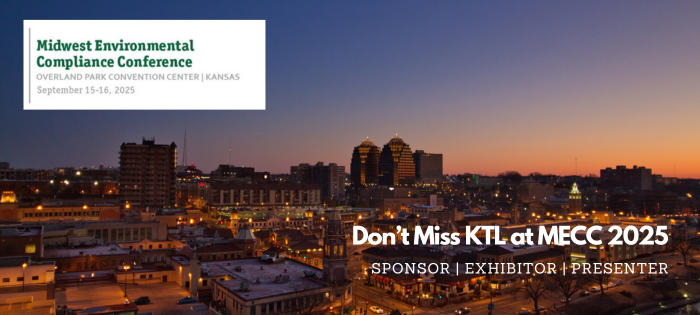
MECC 2025: KTL to Present on OSHA Fundamentals, IT Tools & EHS Challenges
KTL is excited to be joining the 2025 Midwest Environmental Compliance Conference (MECC) in Overland Park, Kansas, September 15-16, 2025, as a sponsor, presenter, and exhibitor. MECC takes a fresh, regional approach to the increasingly difficult task of environmental compliance, permitting, enforcement, and other critical environmental issues that impact Midwest facilities and institutions.
KTL will be leading the following sessions as part of the workshop’s technical agenda:
OSHA Fundamentals for Advancing Environmental Professionals
September 15, 2025 | 8:45 am | Presenter: April Greene, CSP, CHMM, Senior Consultant
Moving from environmental specialist to EHS leader means you suddenly need to know about fall protection, lockout/tagout, confined spaces, and more. This session gives environmental professionals the strategic safety overview on critical safety programs.
IT Tools for EHS Compliance: Demo
September 15, 2025 | 11:15 am | Presenter: Joseph Kunes, Consultant
Building an EHS IT system doesn’t have to be complicated or expensive. Most companies already
have the software they need. Learn how to build data management tools to collect, track, & report EHS
compliance information using the latest Microsoft 365 and Power Platform apps. See examples and
hear from EHS/IT experts on how you can benefit from this approach.
Navigating EHS Challenges in the Food Industry: Panel
September 16, 2025 | 9:40 am | Moderator: Joe Tell, Principal
In the fast-paced and highly regulated world of food production, EHS professionals play a critical role in maintaining operational excellence while protecting workers, consumers, and the environment. This panel brings together experienced EHS managers from across the food industry to share real-world insights, lessons learned, and practical strategies for overcoming today’s pressing EHS challenges. The session will offer takeaways to strengthen your EHS programs and drive continuous improvement.
And be sure to stop by and visit our booth in the exhibit hall. We look forward to seeing you at MECC!

KTL to Exhibit at the 155th Congress of Correction
KTL will be exhibiting at the American Correctional Association’s 155th Congress of Correction in Denver, CO, August 21-26, 2025. The Congress features a wide array of workshops and sessions focused on cutting-edge topics for correctional facilities. The educational workshops feature the best in the business, passing on critical knowledge and engaging in important discussions, while the expansive exhibit allows attendees to interact with hundreds of companies serving the correctional industry.
Be sure to stop by and visit KTL at Booth #871. We look forward to seeing you at the Congress of Correction!

The Business Case for Second-Party Audits
All types of organizations and operational processes demand a variety of audits and assessments to evaluate compliance with requirements—ranging from government regulations, to industry codes, to management system standards (e.g., ISO, GFSI), to internal obligations. Audits and assessments capture regulatory compliance status, management system conformance, supplier compliance, adequacy of internal controls, potential risks, and best practices.
Internal audits help identify problems so corrective/preventive actions can be put into place and then sustained and improved prior to third-party certification/compliance audits. Internal audits and assessments also help companies with continuous improvement initiatives.
Understanding the Internal Audit Process
Many organizations conduct internal audits with their own staff to assess conformance and identify opportunities for improvement. For companies large enough to have a dedicated internal audit team (with have no ties to the processes they audit), this may make perfect sense. However, it can take significant resources—time, personnel, money—to conduct all internal audits with internal resources.
It is easy to underestimate what goes into a successful audit and assume that it is more efficient and cost-effective to use internal resources. But that often isn’t the case. Let’s consider what an internal audit entails.
Pre-Audit Preparation
- Research: Auditors must understand the standard they are assessing against (i.e., regulatory, management systems, internal, industry). Effective auditors will also understand industry best practices; related local, state, and/or country-based requirements; processing norms for new product areas; etc. that can impact operational compliance and risks.
- Logistics: Logistics includes coordinating with the facility(ies) to schedule the audit and time with applicable personnel for interviews and, if travel is required, researching/booking flights, booking hotels, arranging for car transportation, etc.
- Document Review: Prior to the onsite audit, auditors should review available documentation (e.g., procedures, policies, programs). This will better inform and guide them on where they should dig more deeply during the audit, as well as help them create effective audit protocol (see below). Pre-audit document review also allows the onsite portion of the audit to remain focused on observing operations, interviewing workers, and verifying physical requirements are being met.
- Audit Protocol/Template: Auditors need to take the time to develop protocol/questions for conducting the audit, as well as standardized reporting templates, before the site visit. A standard protocol will make conducting multiple audits more efficient. Consistent protocols and templates also add value by allowing for direct year-over-year and site-to-site comparisons.
Onsite Audit
- Technical Knowledge: To efficiently conduct an audit, auditors must have a thorough understanding of the standard they are assessing against. In many cases, auditors are asked to juggle multiple areas of focus at once. For example, in a foods facility, the auditor may simultaneously evaluate Food and Drug Administration (FDA), U.S. Department of Agriculture (USDA), Global Food Safety Initiative (GFSI), and facility-specific procedure requirements. For an environmental, health, and safety (EHS) audit, the auditor may simultaneously assess Environmental Protection Agency (EPA), Occupational Safety and Health Administration (OSHA), state agency, and facility-specific requirements. Deep technical knowledge of all the related standards and codes helps to ensure a thorough audit.
- Audit Tools: Having the right tool for the job can make audits significantly more efficient. This includes the audit protocol and templates developed as part of pre-audit preparation, as well as audit tools that may be used to conduct and manage audits more efficiently and effectively.
- Audit Management: Auditors are responsible for building a relationship of trust and openness with the facility quickly, while still maintaining control of the audit. This can be a challenge for internal auditors when interviewing colleagues and assessing internal systems.
Post-Audit Follow-up
- Report: Auditors need to synthesize observations from the audit to create a report that concisely conveys all pertinent information, including nonconformances with the defined standard(s). Auditors provide additional value when they can leverage their industry experience to prioritize findings and identify opportunities for improvement and best practices. Reports are most valuable when finalized within a few weeks of the site visit when information is fresh to facility staff.
- Corrective Actions: After an internal audit, facility staff will inevitably have questions regarding findings and what to do next. Auditors can provide valuable support by offering recommendations, building corrective action plans, and supplying technical guidance.
Many organizations do not have dedicated internal auditors—rather, internal auditing is an “add-on” responsibility—so time spent completing these internal audit activities takes time away from other business responsibilities. This often results in a post-audit period where the internal auditor has significant catchup to complete other work that has been put on the backburner while conducting the internal audit.
Value of a Second-Party Auditor
A second-party auditor can provide an objective assessment of overall compliance status and, in many cases, do it more efficiently than organizations are able to do with their own resources. A second-party auditor has the time required to conduct the audit, travel, review documents, and create a report. Beyond that, a second-party auditor also has audit tools and templates to create efficiencies when conducting the audit and reporting, can consolidate audit trips, and can spend dedicated time completing all audit activities as efficiently as possible without needing to factor in other business responsibilities.
Beyond saving significant resources, using a second party to conduct audits provides significant business value and additional return on investment:
- Objectivity: Enlisting a qualified outside firm to conduct an audit provides a fresh set of unbiased eyes to assess aspects of your program internal staff may not consider or see. Second-party auditors offer broad perspective and knowledge of best management practices from conducting audits across industries and standards. They maintain ongoing, up-to-date awareness of current and pending regulatory requirements that the organization should consider.
- Customizable: The audits themselves can be customized to fit the needs and goals of the organization. A second-party auditor can provide more direct coverage to evaluate specific program effectiveness and allow for a more focused understanding of existing strengths and improvement areas. Whether there is a desire to prepare for unannounced regulatory agency visits, review plans and programs, assess supplier compliance, or even verify applicability, second-party audits can be built to address the organization’s identified concerns and help manage risks.
- Effective Tools: Second-party auditors often bring effective audit tools to help conduct and manage audits. These tools capture regulatory compliance status and certification system conformance more efficiently, track audit progress/completion status by subject, and generate reports that can be used by management to inform decision making.
- Efficiency: Audits performed internally can take resources away from normal business operations not only when conducting the audit, but also when catching up on daily responsibilities and work that is set aside during the audit. Second-party auditors work with the resources allocated to them to conduct an audit in a timely manner that does not negatively impact business functions. These audits minimize the overall disruption in business compared to internal audits.
- Validation: Second-party auditors validate existing programs and identify areas where best practices can be implemented to further protect the company. They assist in identifying and prioritizing issues before they become violations—focusing on implementing and closing corrective actions. They also provide data and reports that can be shared internally with employees to improve performance or externally with communities or customers to bolster the company’s image.
- Consistency: Using the same second-party auditor to conduct your audits creates consistency across locations and over time. This allows the organization to establish a benchmark for performance that can be used to help ensure continuous improvement throughout the organization and its supply chain.
Second-party audits are not just about checking boxes—they are about building stronger partnerships, spotting issues early, and keeping your business running smoothly. Don’t wait for nonconformances to catch you off guard. Implementing second-party audits isn’t just a compliance tool, it is a strategic advantage.

Comments: No Comments
Is It Actually Empty?
Virtually every regulatory agency has regulations that require companies to fulfill very specific compliance requirements. Sometimes, there is overlap and businesses may be required to comply with similar—yet different—regulations from two different agencies. Using containers to store hazardous waste products is one of those tricky situations.
Different Definitions
Containers used for hazardous materials or waste are regulated under the Department of Transportation’s (DOT) Hazardous Materials Regulations (HMR) (49 CFR 173.29) and the Environmental Protection Agency’s (EPA) Resource Conservation and Recovery Act (RCRA) Hazardous Waste Requirements (40 CFR 261.7). The confusion between these rules comes in the definition of empty, which changes significantly from one agency to the next.
For both agencies, the definition of empty dictates how containers that once held hazardous waste and/or hazardous materials are managed (i.e., shipped and disposed of). However, a container can meet the criteria for emptiness according to EPA but still not be considered empty according to DOT for transportation purposes. It is important to understand the different definitions to be able to comply.
EPA RCRA-Empty
The EPA regulations regarding management of empty containers and residues establish procedures for determining if a container is empty (i.e., no longer contains hazardous waste) and defining when hazardous waste residue in an empty container is exempt from regulation. According to EPA, an empty chemical container has been removed of all materials or liquids via commonly employed practices (e.g., pumping, pouring, or aspirating). But what does this actually mean?
RCRA-empty conditions differ based on whether the container is holding non-acute hazardous waste, acute hazardous waste, or hazardous waste in compressed gas form, as shown in the table below.
| Waste Type | RCRA-Empty Conditions |
|---|---|
| Non-acute hazardous waste | 1. All wastes have been removed using commonly employed practices, and no more than 1 inch or residue remains; or 2. No more than 3% by weight of the container remains for containers < 119 gallons; or 3. No more than 0.3% by weight of the container remains for containers > 119 gallons. |
| Acute hazardous waste (P-listed wastes, other Code H hazardous wastes) | 1. Container is triple rinsed with material capable of removing acute waste; or 2. Container is cleaned by an alternate method that is scientifically proven to achieve equivalent waste removal; or 3. Inner liner that prevents contact between the container and waste is removed. |
| Compressed gases | The pressure within the container approaches atmospheric pressure. |
Containers that meet the definition of RCRA-empty are exempt from requiring specialized management as a hazardous waste. RCRA-empty containers can be disposed of at an authorized municipal solid waste landfill, recycled through a legitimate recycler, or reused onsite. Reuse requires properly emptying the container to avoid mixing incompatible substances that may create human health or environmental concerns. If a container is not found to be RCRA-empty, any residues removed from the container must be managed as hazardous waste under Subtitle C.
DOT Empty
DOT is responsible for hazardous materials shipping regulations. Unlike RCRA, DOT hazards are not defined by the quantity of material in the container; rather, the properties of the material dictate hazards. Even when a container appears empty, the hazardous material residue may still pose a hazard under the HMR. Per 49 CFR 173.29(a), these containers must follow the same rules as full hazmat containers when it comes to shipment. This includes having shipping papers, placards, labels, and markings, as well as providing training for employees who prepare the containers (full or empty) for shipping.
A container that once held hazardous materials is only considered exempt from HMR under the following conditions:
- The container remains unused.
- The container has been thoroughly cleaned and sufficiently purged of vapors to eliminate potential hazards.
- The container has been refilled with non-hazardous material to neutralize any remaining hazards from residue.
In addition, if the material inside the container is a DOT Class 9 material and meets the definition of RCRA-empty, the container is exempt from both EPA hazardous waste and DOT hazardous material shipping requirements.
Containers that meet the DOT criteria for being truly empty must have any hazard labels, markings, or placards that would be visible in transportation removed, covered, or obliterated to ensure emergency responders can correctly identify that the package contains no regulated hazardous materials.
Empty, Full, or Both?
In short, it is possible to have a container that EPA considers empty, but DOT does not. In this case, if you plan to ship the container, you would not have to follow any EPA hazardous waste rules, but DOT HMR would still apply when shipped.
A regulatory applicability assessment is a good first step in determining which regulations apply if you store hazardous waste in containers and/or plan to ship hazardous materials. If DOT’s HMR and EPA’s RCRA Hazardous Waste Requirements, it is then important to understand the distinction between the rules regarding what is considered empty to comply with both agency’s requirements.

Comments: No Comments
5 Tips to Become a Recycling Superstar
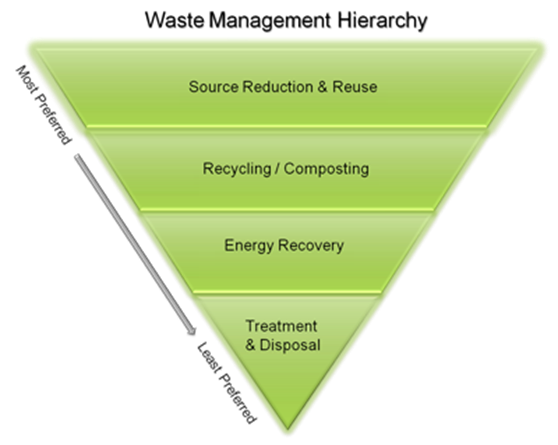
No single waste management strategy is suitable for managing all waste streams in all situations (Environmental Protection Agency (EPA)). As such, EPA’s non-hazardous materials and waste management hierarchy ranks the various waste management strategies from most to least environmentally preferred. Not surprisingly, the hierarchy emphasizes reducing and reusing—followed by recycling—as best practices for sustainable materials management, when possible.
While the best way to reduce waste is to never create it, recycling is a valuable way to collect used, reused, or unused items that would otherwise be considered waste and turn them into something valuable. From Fortune 500 companies to local businesses, to the restaurant on the corner—all have materials that can and should be recycled. The five tips below offer best practices for effectively managing your recycling efforts.
1. Conduct a trash audit.
A trash audit is a process in which an organization systematically analyzes and evaluates the contents of its waste, typically by sorting through the trash to identify the types and quantities of materials being discarded. This in-depth process provides a good baseline in developing a Recycling Program, as it helps to document the contents and quantity of your waste streams and then allows you to define how that waste gets managed.The audit helps to answer questions such as: What are you throwing away? How much is wasted food? Can you separate that out and send it to a composter? Can you stop making that trash? Can you reuse something? Can you sell it to someone else? Can you recycle it?
While not all trash can be reused or repurposed, it is consistent with EPA’s hierarchy to identify the materials produced that can be reused or repurposed as the first and most sustainable waste management solution (e.g., some tools can be sent back to the manufacturer to be refurbished and resold, or there may also be a “second life” outlet for materials). If materials are not able to be reused, the next best consideration is recycling.
2. Understand state and local regulations.
Once your trash audit identifies what items you want to recycle, it is important to consider the regulations. Different states and local governments may have specific requirements for the materials you want to recycle. For example, many states have compliance requirements for electronic wastes, used oil, or other universal wastes. In addition, EPA has very specific requirements for solid and hazardous waste recycling to ensure it is managed properly to avoid environmental and safety hazards. Engage experts, where necessary, if you have questions about certain materials that may have very specific or unclear requirements.
3. Implement a Recycling Program.
Based on the trash audit and regulatory requirements, a Recycling Program can be developed to serve as the roadmap for what gets recycled and how. The Recycling Program should clearly:
- Define what materials get recycled.
- Discuss proper disposal of materials, focusing on the most common items employees would handle in their day-to-day tasks.
- Identify collection points, so employees understand where to put items for recycling.
- Detail storage procedures for recyclable materials.
- Outline roles and responsibilities, including the parties responsible for recycling (see below).
- Provide for worker training to ensure the program is followed as intended.
- Reinforce the purpose of recycling and leadership’s commitment to the cause.
- Address how the program will be communicated to visitors, contractors, customers, shareholders, etc.
4. Partner with the right recyclers.
An important part of your Recycling Program is finding reputable recyclers who understand recycling regulations and are certified to handle the materials you are generating. This means working with recyclers who are transparent. Recyclers who are open about their practices are less likely to mishandle your recyclables than shady operators who could end up getting your company in a lot of trouble. Your recycler should help you identify the best ways to recycle your materials (e.g., setting up separate dumpsters for paper, plastic, food) and identify whether there are any cash-back opportunities for recycling certain materials (e.g., cardboard, scrap metal, electronic waste, etc.).
5. Maintain safe storage and handling practices.
As noted above, a trash audit will help you know what you are recycling. You also need to know how to properly store these materials while they are waiting to be recycled so they do not become a bigger hazard. For example, keep batteries for recycling in cool, dry places away from heat.
Conduct a proper risk assessment for the proposed storage spaces to capture and mitigate potential risks before finalizing your choice, document this in your Recycling Program, and then train employees on how to safely handle the material they are bringing to the recycling area. Precautions may include having the proper fire detection and suppression equipment for the area where you are storing material for recycling, or ensuring employees have the proper personal protective equipment (PPE) to wear when handling materials.
Creating a Recycling Culture
The above five tips can help ensure you have the systems, practices, programs, and partners in place to manage your trash and recycling. By following them, organizations can streamline their waste management processes, comply with environmental standards, and promote resource conservation and cost savings. But to truly become a “recycling superstar”, it is also important that you:
- Avoid all or nothing thinking—set realistic goals for what you can accomplish while still complying with regulations.
- Implement robust quality control processes to avoid making mistakes.
- Think creatively about how your team can work together reduce, reuse, repurpose and recycle your trash and get closer to zero waste.
- Measure your results. Conduct your trash audits annually to assess what is working and what is not and then set new goals to continually improve.
Effective waste management and recycling are essential for organizations striving to operate sustainably and reduce their environmental impacts. Ultimately, fostering a culture of creativity, continuous improvement, and accountability will lead organizations closer to their zero-waste goals, benefiting the environment and the bottom line.

Comments: No Comments
EHS: Top Trends for 2025
Every year, we see a number of environmental, health, and safety (EHS) trends rise to the surface that have the potential to impact many industries. As we enter 2025, some challenges and opportunities in EHS remain ongoing; some are just gaining traction with impacts yet to be known, particularly with a change in Administration just taking hold. Here are some of the top EHS trends KTL is keeping watch on in 2025…
Regulatory Landscape
In 2022, the Environmental Protection Agency (EPA) published its FY 2022-2026 EPA Strategic Plan to communicate the Agency’s vision, priorities, and strategies. Specifically, the Plan includes targeted objectives and outcomes in the areas of climate change; environmental justice; compliance enforcement; clean land, air, and water; and chemical safety. The Occupational Safety and Health Administration’s (OSHA’s) focus centers on National Emphasis Programs (NEPs) for 2025 related to combustible dust, fall protection/prevention, heat, silica crystalline, and warehousing and distribution center operations, as well as many regional directives.
With a new Administration taking office in January, a big unknown of the coming four years is how the EHS regulatory landscape will change. There is speculation regarding plans to reorganize the EPA and establish “pause and review” teams to assess major rules, guidance materials, grants, legal settlements, budgets, etc. How this will translate into regulatory action remains to be seen.
Update: According to InsideEPA.com, acting EPA Administrator James Payne issued a directive on January 24, 2025, ordering all EPA staff to stop all communications with external parties pending further instruction. Exemptions will allow EPA staff to continue to communicate with state and federal agencies, provided they do not discuss enforcement matters; talk to relevant partieis to facilitate imports; and continue conducting inspections. It is unclear at this time how long the directive will remain in place.
Mental Health
Companies are increasingly recognizing that traditional safety programs must evolve to prioritize mental health as much as physical health—from mental health days to employee assistance programs, to stress management training, to flexible work hours. Correspondingly, psychological safety is becoming a critical concept for building effective teams and encouraging workplace innovation and success. A psychologically safe culture allows employees to take reasonable risks in a safe environment without negative interpersonal consequences.
A related concept is safety culture, which is concerned with many cognitive aspects of safety, like norms, perceptions, beliefs, and values. Emphasizing mental health as part of the organization’s safety culture may become a priority for mature organizations. As the concept of total worker health continues to expand, the focus on mental health is also likely to be reinforced by new regulations and standards regarding psychological safety in the workplace.
Sustainability and Climate Change
Environmental, Social, and Governance (ESG) initiatives have dominated many corporate agendas for the past several years, particularly with Europe and Canada advancing standards related to sustainability and climate change data reporting and ISO’s recent Climate Change Amendments. Many organizations have worked to significantly improve their data collection efforts and have integrated climate change management and circular economy principles into their sustainability strategies.
The change in Administration may increase scrutiny regarding the value of these ESG initiatives. We have already seen the Securities and Exchange Commission’s (SEC) March 2024 Climate-Related Disclosures Rule stayed due to multiple petitions and lawsuits. This may be a sign of things to come. Many companies have invested in their ESG efforts and will continue to do so, but 2025 may present an opportunity to reassess and streamline initiatives to ensure they are practical and upholding sustainability goals, while also contributing value to the company.
PFAS
Per- and polyfluoroalkyl substances (PFAS) became a focal point for EPA in 2021 with the publication of its PFAS Strategic Roadmap, which committed to addressing concerns related to PFAS exposure. Actions have included improving reporting on PFAS, as well as adding seven additional PFAS to the Toxics Release Inventory (TRI) in January 2024 and an additional nine in January 2025. In April 2024, EPA announced three more notable actions, including introducing the first-ever national drinking water standards and designating perfluorooctanoic acid (PFOA) and perfluorooctane sulfonic acid (PFOS) as “hazardous substances” under Superfund. In addition, the updated Interim Guidance on the Destruction and Disposal of PFAS and Materials Containing PFAS will require entities to report releases of these “forever pollutants” that exceed threshold quantities.
Beyond federal regulations, many states are introducing policies related to PFAS, including monitoring and testing for PFAS in water and sewage sludge and banning PFAS in food packaging, clothing, and other consumer products. Organizations need to address PFAS in their operations, products, supply chains, and waste streams; stay informed about ongoing PFAS regulatory developments; and adjust compliance programs and operational practices, as needed.
Personal Protective Equipment (PPE)
Properly fitting PPE is essential for workers to complete their tasks safely. If PPE is not correctly fitted to the body, it can cause discomfort and increase the risk of workplace accidents and injuries. On December 11, 2024, the Occupational Safety and Health Administration (OSHA) announced its finalized revision to the PPE Standard for Construction, which requires PPE to properly fit any construction worker who needs it, including women and physically smaller or larger workers.
Employers must ensure that every employee not only has the right PPE, but that it also fits. Fit testing may identify the need for PPE alternatives to meet the anthropometric needs of all workers. Importantly, employees must be trained and empowered to speak up if PPE does not fit appropriately to ensure their safety.
Technology/AI
Artificial intelligence (AI) and machine learning technologies have the capacity to significantly alter how companies manage their EHS programs. While still not fully mature, these technologies are becoming more sophisticated. As AI evolves and becomes more generally accepted, more companies are likely to start adopting it to automate routine compliance tasks, conduct EHS assessments, perform training simulations, predict potential safety incidents, monitor workplace conditions in real-time, and more.
While the efficiencies and other benefits of technology solutions are many, the increased reliance on AI and machine learning will require increased oversight and management. In particular, companies will need to determine where automation is appropriate and where the human factor is still required. Not all processes lend themselves to AI. It will also be imperative to consider stronger data privacy protocols to ensure the security of the company.
Others to Watch
- OSHA Reporting: On January 1, 2024, the Department of Labor’s (DOL’s) final rule requiring employers in designated high-hazard industries to electronically submit injury and illness information to OSHA took effect. KTL inspections routinely find errors and omissions in OSHA recordkeeping. Effective solutions, particularly areas where hard copies can be replaced by digital forms, are needed.
- Hazard Communication Standard: The final Hazard Communication Standard took effect on July 19, 2024, implementing the first major updates since 2012. The first compliance date requires chemical manufacturers, importers, and distributors to update labels and Safety Data Sheets (SDSs) for chemical substances by July 19, 2026.
- Lead Levels: In January 2024, the EPA reduced the acceptable amount of lead in soil for residential exposure, stating that no level of lead is acceptable. These reduced levels may soon be translated into commercial exposures.
- One Health: Both the Society of Environmental Toxicology and Chemistry (SETAC) and Society of Toxicology (SOT) have adopted One Health initiatives as an integrated, unifying approach that aims to sustainably balance and optimize the health of people, animals, and ecosystems (SOT). The idea is to look at the health of our environment and all aspects of our environment as a whole and not one component at a time. This idea is being translated into health impact assessments.
- Pesticide/Herbicide Re-evaluation: The EPA has initiated re-evaluations of registered pesticides, herbicides, rodenticides, and fungicides, including the highly publicized Roundup. These reviews are expected to result in a recommendation to focus the use of these chemicals rather than using a general broadcast application.
- Microplastics: Microplastics have been found in every ecosystem on the planet—in food, beverages, and human and animal tissue. Scientists do not fully understand the impacts of microplastics on human health and aquatic life, and industry is struggling with how to manage them due to their pervasive nature and wide variety of shapes and sizes. Ongoing research in pollution prevention will be forthcoming.
Getting Ahead in 2025
In 2025, organizations will continue to encounter evolving workplace challenges, regulatory adjustments, societal demands, economic pressures, and rapid advancements in technology—some of which can be anticipated, some which remain to be seen. KTL suggests completing the following early in 2025 to prepare for whatever is on the horizon:
- Get senior leadership commitment. Even with the best EHS personnel, the organization and its EHS system will only be as strong as the top leadership and what they prioritize.
- Stay abreast of regulatory developments. Monitor what is going on at the federal (i.e., EPA and OSHA) and state levels, assess your regulatory applicability, and evaluate how any potential regulatory changes over the next year(s) may impact your operations.
- Conduct a comprehensive gap assessment to ensure you are efficiently meeting your EHS requirements (i.e., regulatory, management systems, internal, supply chain). Think critically about how overlapping requirements may apply (e.g., your chemical inventory may uncover requirements for air permitting, waste management, Tier II report, etc.) and how you can integrate systems to improve efficiency and compliance.
- Determine where you can integrate technology solutions into your operations. This could mean stepping into the world of AI and machine learning; it could also mean implementing compliance information management systems to help manage compliance and reporting requirements. Technology advancements can help create significant business efficiencies when used appropriately.
- Seek third-party oversight. Many EHS departments are severely understaffed. Having external experts periodically look inside your company provides an objective view of operations, helps you to prepare for audits, and allows you to implement corrective/preventive actions that ensure compliance. An outside expert can often provide the “big picture” view of what you have vs. what you need; how your plans, programs, and requirements intersect; and how you can best comply with changing requirements.

KTL to Join the Technical Program of the SETAC Annual Meeting
KTL will be joining the technical program of the Society of Environmental Toxicology and Chemistry (SETAC) North America 45th Annual Meeting October 20-24, 2024 in Forth Worth, TX. SETAC is dedicated to advancing environmental science and science-informed decision-making through collaboration, communication, eductaion, and leadership.
KTL Senior Consultant Margaret Roy will be co-chairing Session 6.04.T – Risk Assessment, Remediation, and Restoration: Applying Interdisciplinary Approaches to Creating Successful Remediation and Restoration Projects on Wednesday, October 23 from 10:00am – 12:00pm.
In addition, KTL is co-author to the following poster, which will be on exhibit all day on Monday, October 21:
Human Health and Ecological Risk Assessment of the Herbicide Flumioxazin for the U.S. Forest Service
5.12.P-Mo-160 | Presenters: Julie Rothrock, SRC, Inc.; Margaret Roy, KTL; and Dan Tekiela, U.S. Forest Service
The United States Department of Agriculture (USDA) Forest Service (FS) is responsible for protecting and managing natural resources on National Forest System lands. Pesticides are one tool used by the FS to prevent, control, or manage forest insects, diseases, and invasive plants. When considering the use of a pesticide on forest lands, the FS conducts a human health and ecological risk assessment (HHERA) to evaluate risk to FS personnel, the public, and the environment, and to then make decisions regarding specific applications of pesticides on forest lands throughout the U.S. This poster presentation outlines the process for conducting theHHERA for the herbicide flumioxazin to estimate the nature and degree of potential risks, both human health and environmental, associated with its use in FS vegetation management programs.
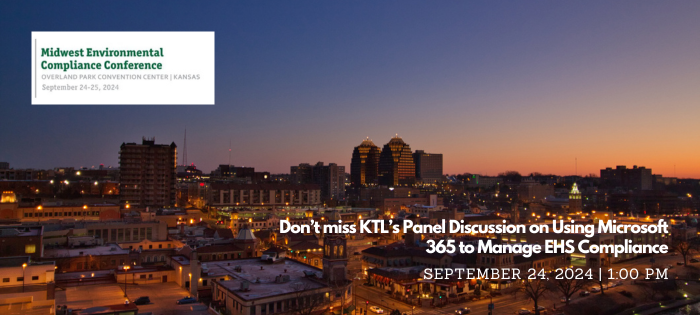
MECC 2024: KTL Leads Panels on Using Microsoft 365 to Manage EHS Compliance
KTL is excited to be joining the 2024 Midwest Environmental Compliance Conference (MECC) in Overland Park, Kansas, September 24-25, 2024. MECC takes a fresh, regional approach to the increasingly difficult task of environmental compliance, permitting, enforcement, and other critical environmental issues that impact Midwest facilities and institutions.
KTL will be leading the following mainstage session as part of the workshop’s technical agenda:
How to make Microsoft 365 your go-to software for managing EHS compliance – user panel
September 24, 2024 | 1:00 pm | Moderator: Joe Tell, Principal
Implementing software to manage EHS compliance sounds expensive, but it doesn’t have to be—not when most companies already have the software they need. Learn how organizations in the utility, education, and manufacturing sectors are leveraging Microsoft 365® and Power Platform® to effectively manage compliance documentation and data.
Panelists:
Tina Baker, City of Lincoln, NE Solid Waste Management Division
Autumn Gentry, Southeast Missouri State University
Emily Muth, Conagra
Brian Wanzenried, P.E., Viterra
And be sure to stop by and visit us at Booth #13. We look forward to seeing you at MECC!
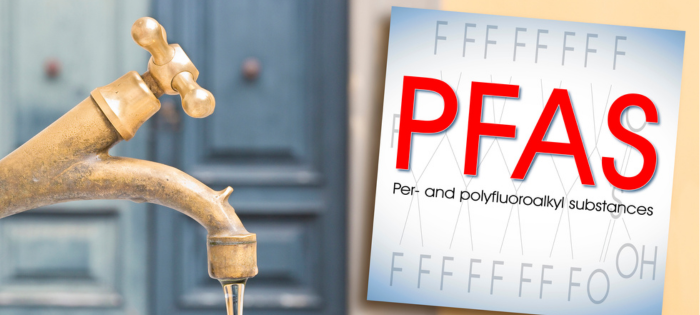
Comments: No Comments
EPA Regulatory Alert: Requirements Increase for PFAS
In 2021, the Environmental Protection Agency (EPA) published the PFAS Strategic Roadmap to confront the human health and environmental risks of per- and polyfluoroalkyl substances (PFAS), also known as “forever chemicals” due to their ability to persist and bioaccumulate in the environment and human body. Through the Roadmap, the Agency has committed to making significant contributions in research and regulations to address concerns related to PFAS exposure. This has included recent actions to improve reporting on PFAS (October 2023), as well as adding seven additional PFAS to the Toxics Release Inventory (TRI) (January 2024).
In April 2024, EPA announced three more notable actions to tackle PFAS contamination.
National Drinking Water Standard
On April 10, 2024, EPA issued the first national, legally enforceable drinking water standard to protect communities from exposure to several PFAS known to occur individually and as mixtures in drinking water. The Safe Drinking Water Act (SDWA) requires EPA to set goals, known as Maximum Contaminant Level Goals (MCLGs), based only on health data and the potential impacts to public. MCLGs are not regulatory levels and are not enforceable. EPA then sets the enforceable Maximum Contaminant Level (MCL) as the highest level of a contaminant that is allowed in drinking water. MCLs are set as close to MCLGs as feasible using the best available treatment technology and taking cost into consideration. The MCLs, which are used for compliance determination, are set at specific concentrations that laboratories nationwide can measure with high certainty.
| PFAS | MCL | MCLG |
| Perfluorooctanoic acid (PFOA) | 4.0 ppt* | 0 |
| Perfluorooctane sulfonic acid (PFOS) | 4.0 ppt | 0 |
| Perfluorononanoic acid (PFNA) | 10 ppt | 10 ppt |
| Perfluorohexane sulfonic acid (PFHxS) | 10 ppt | 10 ppt |
| Hexafluoropropylene oxide dimer acid (HFPO-DA, aka “GenX Chemicals”) | 10 ppt | 10 ppt |
| Mixtures of any two or more of PFNA, PFHxS, perfluorobutane sulfonic acid (PFBS), and GenX Chemicals | Hazard Index** (unitless) | Hazard Index** (unitless) |
** The Hazard Index is a long-established approach that EPA regularly uses to determine the health concerns associated with exposure to chemical mixtures. EPA’s Hazard Index MCL is set at 1.
Under the standard, initial PFAS monitoring requirements mandate larger systems (i.e., serving more than 10,000 people) take four quarterly samples, while smaller systems (i.e., serving fewer than 10,000 people) take biannual samples. All public water systems have three years to complete initial monitoring for these chemicals and inform the public of the PFAS levels measured in the drinking water. Where PFAS exceeds the MCL, systems must start implementing solutions to reduce PFAS in their drinking water within five years. Drinking water systems have the flexibility to determine the best solution for their community based on a range of available approaches (e.g., granular activated carbon, reverse osmosis, and ion exchange system).
EPA estimates 6-10% of the 66,000 public drinking water systems subject to this rule may need to take action to reduce PFAS to meet the standards. As such, the Agency also announced nearly $1 billion in newly funding available through the Bipartisan Infrastructure Law to help states and territories implement PFAS testing and treatment at public water systems.
Now that EPA has finalized MCLs, states that have already established enforceable drinking water standards for PFAS (e.g., Maine, Massachusetts, Michigan, New Hampshire, New Jersey, New York, Pennsylvania, Rhode Island, Vermont, Washington, and Wisconsin) must adhere to the federal standards if they are stricter or adopt new drinking water standards that are at least as stringent as the federal standards.
The new Rule is expected to put increased pressure on industry to reduce the presence of upstream PFAS contamination, eliminating it before it reaches the drinking water supply.
Superfund Designations
On April 19, 2024, EPA designated two widely used PFAS chemicals—PFOA and PFOS and their salts and structural isomers—as hazardous substances under the Comprehensive Environmental Response, Compensation, and Liability Act (CERCLA, aka Superfund). This designation will allow EPA to address more contaminated sites, take earlier action, expedite cleanup, and ensure the polluter pays for the costs to clean up PFAS contamination.
Under the Rule, entities are required to report releases of PFOA and PFOS that meet or exceed the reportable quantity of one pound within a 24-hour period to the National Response Center, as well as state, tribal, and local emergency responders. As a discretionary statute, CERCLA affords EPA the discretion to then decide how to respond to a release based on whether it poses unacceptable risk to human health or the environment. It allows EPA to use one of its strongest enforcement tools to make polluters pay for investigations and cleanup rather than taxpayers through the Superfund Trust Fund.
The final Rule also requires federal entities that transfer or sell their property to provide notice about the storage, release, or disposal of PFOA or PFOS and guarantee (through a commitment in the deed) that contamination has been cleaned up or, if needed, that additional cleanup will occur in the future.
EPA is also issuing a separate CERCLA enforcement discretion policy to clarify that the Agency will focus enforcement on parties that have manufactured PFAS or used PFAS in the manufacturing process, federal facilities, and other industrial parties. It is not the Agency’s intent to pursue other parties, such as farmers, municipal landfills, water utilities, municipal airports, and local fire departments.
The Superfund designation is especially important, as delays in addressing contamination may worsen contamination as PFOA and PFOS have more time to migrate into water and soil. The designation may also encourage better waste management and/or treatment practices by facilities handling PFOA or PFOS to minimize releases, reduce CERCLA notification requirements, and mitigate liability risk.
This Rule puts PFOS and PFAS on equal ground with other hazardous substances regulated under Superfund. The addition will likely increase scrutiny of properties for potential PFAS releases that may impact negotiations and property values and result in liability for property owners. In addition, Section 306 of CERCLA further requires the Department of Transportation to list and regulate these substances as hazardous materials under the Hazardous Materials Transportation Act.
Destruction and Disposal
Finally, EPA has issued updated Interim Guidance on the Destruction and Disposal of PFAS and Materials Containing PFAS. The document offers guidance and recommendations for managers of PFAS and PFAS-containing materials to protect human health and the environment, including a new technology evaluation framework to help analyze the safety and effectiveness for new destruction and disposal (D&D) technologies.
In the Guidance, EPA encourages the use of D&D options that have a lower potential for releasing PFAS into the environment. It does not establish requirements for D&D of PFAS materials. The Guidance focuses on the following:
- Underground injection (UIC): Permitted Class I non-hazardous industrial or hazardous waste injection wells are designed to isolate liquid waste deep below the land surface to protect underground drinking water sources.
- Landfills: Permitted hazardous waste landfills are recommended when PFAS concentration is relatively high. Hazardous waste landfills have leachate emission protections to help control the environmental release of PFAS, which are important for PFAS-containing materials that may break down more easily in landfills.
- Thermal treatment: Permitted hazardous waste combustors and granular activated carbon reactivation units operating under certain conditions can destroy PFAS, while minimizing releases and exposures; however, some uncertainties remain.
- Interim storage with controls: While not a D&D technology, storage may be a short-term alternative for some PFAS materials, such as containerized or high PFAS-content materials. With proper controls, interim storage can control PFAS migration.
The Guidance encourages testing a range of methods at thermal treatment facilities before accepting large quantities of PFAS-containing materials. EPA has also released a new analytical test method (OTM-50) to help collect more data and answer questions.
More to Come…
Federal and state initiatives and regulations to manage PFAS are rapidly growing. KTL does not see the challenges associated with PFAS going away any time soon. If anything, we anticipate more facilities will be directly impacted by mitigation efforts and regulatory action to support EPA’s PFAS Strategic Roadmap, such as those outlined above.
It is important for facilities to have a good understanding of PFAS and PFAS-containing chemicals used onsite. Implementing a chemical inventory management system that documents and manages PFAS data can help ensure the facility meets these new requirements. Proper usage and disposal strategies, a comprehensive environmental management system (EMS), and a forward-thinking Emergency Response Plan will also remain vital tools for companies potentially dealing with PFAS to effectively manage the associated risks.
